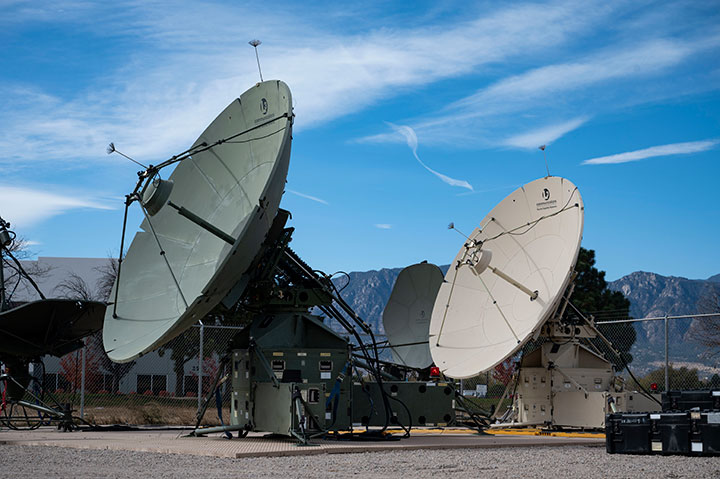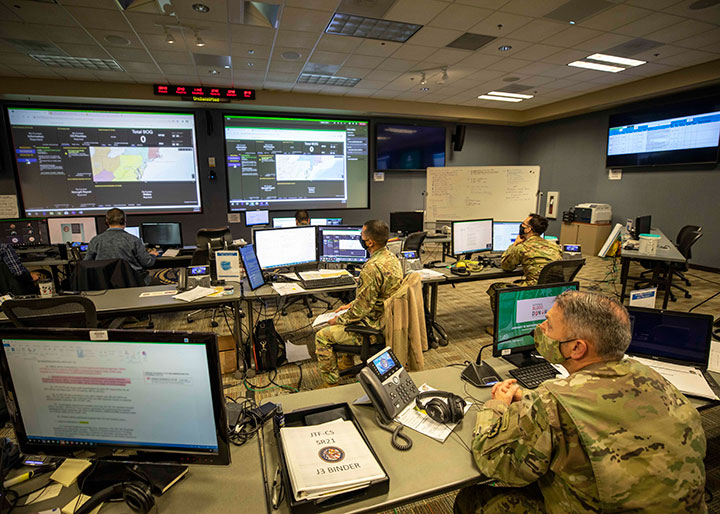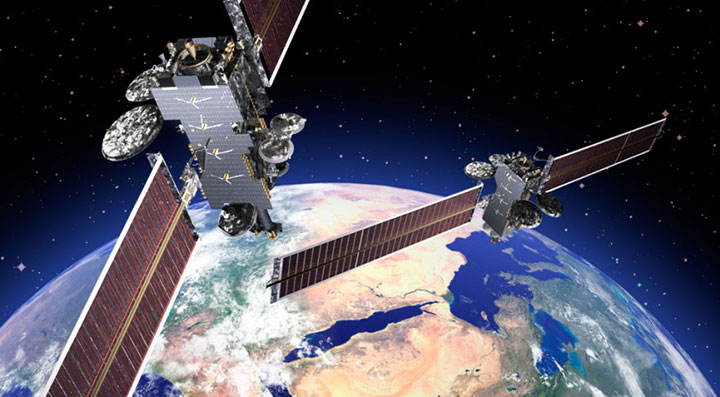ALEXANDRIA, Va. — MILSATCOM terminal upgrades will be an area to watch in 2023 as global militaries continue investing in national security space capabilities.
 This Nov. 2, 2022, photo shows the Quad-band Large Aperture Antenna (QLAA) and Ground Multi-band Terminal (GMT) satellite dishes used by the U.S. Space Force. (U.S. Air Force photo by 1st Lt. Charles Rivezzo)
This Nov. 2, 2022, photo shows the Quad-band Large Aperture Antenna (QLAA) and Ground Multi-band Terminal (GMT) satellite dishes used by the U.S. Space Force. (U.S. Air Force photo by 1st Lt. Charles Rivezzo)
“In general, 2023 looks to be a year of change,” said Sarah Halpin, a research analyst at NSR. In a recent set of 2023 predictions, Halpin cited government and military satcom terminal upgrades as an “increasingly prominent” area of transformation in the space and satellite market.
Several nations plan to expand MILSATCOM constellations, make further progress on contracts and build out new capabilities and security features. Major programs include the U.S. Joint All Domain Command and Control (JADC2), the U.S. Army’s gateway and remote terminal modernization, Australia’s JP 9102 program for a sovereign MILSATCOM capability and efforts by NATO members to harden terminals against jamming and cyberattacks.
These developments are coming at a time when economic pressures and tighter markets are impacting the commercial satellite industry. Government plans to recapitalize MILSATCOM investments could prove a “bright spot” as a driver of future revenue growth, according to NSR.
Primarily, nations are upgrading older MILSATCOM terminals to support resilient, capable and secure communication systems to withstand today’s cyber and electronic warfare environment.
“The need to not be left behind in such a quickly evolving and developing climate is going to be a strong motivator for end users looking to secure rapidly deployable, strong MILSATCOM solutions,” Halpin said. “Upgrades are going to support resilience, deter jamming, allow dynamic responses and the ability to deter losses of individual satellites.”
Urgency of Near-Peer Competition
Geopolitical tensions over the last year have highlighted both the physical and cybersecurity vulnerabilities of satcom networks. Awareness of these risks was prevalent before the conflict in Ukraine and rising tensions in the Indo-Pacific. But recent events, as well as declarations that commercial satellites may be considered legitimate military targets, have prompted actionable progress toward resilient satcom solutions, assured access to space and asset security.
 In this Oct. 31, 2022, photo, U.S. Air Force Lt. Col. Mike Johnson, 26th Space Aggressor Squadron space control operator, performs a feed swap on an antenna during a CRIMSON SKIES exercise to train MILSATCOM operators. (U.S. Air Force photo by 1st Lt. Charles Rivezzo)
In this Oct. 31, 2022, photo, U.S. Air Force Lt. Col. Mike Johnson, 26th Space Aggressor Squadron space control operator, performs a feed swap on an antenna during a CRIMSON SKIES exercise to train MILSATCOM operators. (U.S. Air Force photo by 1st Lt. Charles Rivezzo)
This reality is accelerating the timeline for military SATCOM solutions, Halpin emphasized. “The geopolitical environment will certainly speed up general demand levels,” she said. “Countries are now at a point where they can’t be left behind technically or in coverage levels.”
The urgency of keeping pace with competitors is reflected clearly in national security space budgets and space doctrines. Government defense space budgets grew 16% in 2022 over the previous year and are expected to continue to grow through the mid-decade. The United States, the largest spender on military space, increased its Space Force budget by nearly 30% in the proposed FY 2023 defense authorization bill. Japan is expected to boost funding for defensive space capabilities to $14 billion in 2023. China invested an estimated $4 billion in military space in 2022 and is pursuing a Multi-Domain Precision Warfare (MDPW) program to counter the U.S. JADC2.
The U.S. is also continuing to accelerate acquisition and deployment through the Space Development Agency. Officials have affirmed that the heightened pace is necessary to meet rapid advancements by near-peer rivals in the space domain.
Normalization of Multi-Dimensionality, Interoperability
The trend toward hybrid networks is expected to continue into 2023 and beyond. Military customers are seeking increasingly capable terminals that support multiple orbits as well as multiple networks, constellation owners, bands and waveforms. According to NSR, these “multi-dimensional networks” will “become the norm” in the near term.
Today’s MILSATCOM networks demand flexible terminals capable of switching between LEO, MEO and GEO satellites, different teleports, frequency bands and data transport channels as a matter of resiliency. Equally important are commercial space solutions that can integrate with military systems.
“Interoperability is going to be the word of the day,” Halpin said. “The big thing to be mindful of is the push toward standardization which is probably going to increase at quite a speed to decade’s end.”
A New Field of Emerging Space Players
As leading space powers in North America, Europe, as well as Japan, China, Russia and India are placing greater policy emphasis on space as a warfighting domain, other emerging space nations are expected to follow suit. While most less developed space powers have focused on civil capabilities, NSR expects greater adoption of satellite communications as a core defense strategy or a military resource.
 Saudi Arabia is expected to increase military space spending throughout the mid-decade. This artist’s rendering shows the Arabsat 6a and Hellas-sat4 geostationary communications satellites. (Source: Lockheed Martin)
Saudi Arabia is expected to increase military space spending throughout the mid-decade. This artist’s rendering shows the Arabsat 6a and Hellas-sat4 geostationary communications satellites. (Source: Lockheed Martin)
“You can see nation-states starting to build their doctrines and capabilities focused on measuring, monitoring and responding to space-based conflict,” Halperin said. “We’re looking at a playing field like we haven’t seen before.”
The barriers to use space as a resource have gotten lower and allowed greater access by nations in the Middle East, Africa and Asia, as well as new European investments. Much of the desire to invest in military space is driven by the growing need for data and assured connectivity in modern warfare. India is undergoing significant growth, primarily in civil space. Saudi Arabia is actively revamping its national space strategy with plans to accelerate space defense spending through the middle of the decade. Nigeria, Singapore, Australia, Iran, Israel and several others are also actively seeking greater national security space capabilities.
It will take significant time and capital for emerging space nations to catch up with the capabilities of space leaders. Commercial vendors will have a role to play in the short and medium term, but that could shift over time, Halpin noted. “It is certainly going to be a substantially different field with substantially different players by decade’s end.”
